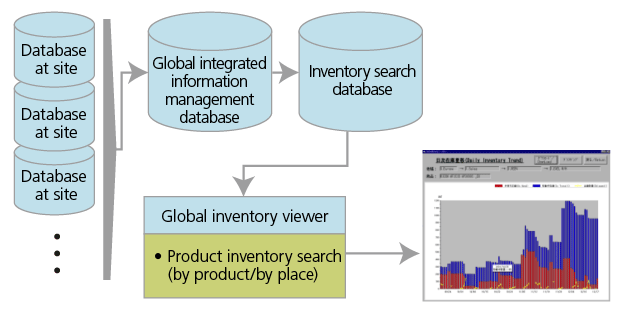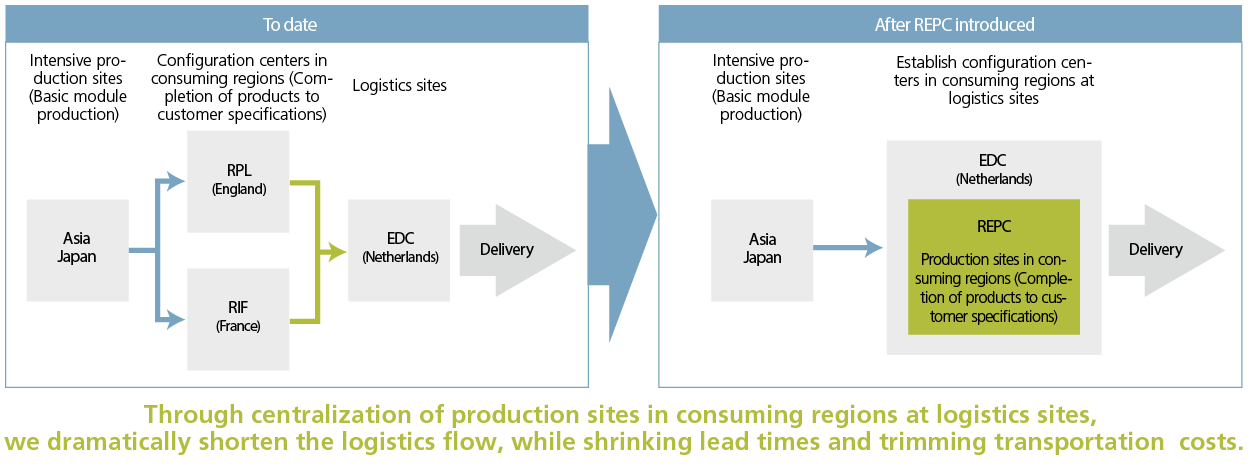- Home
- Sustainability
- Reports on Ricoh's ESG
- Supply Chain Management
Supply Chain Management
Global SCM reorganization brings us closer to the customer and raises profitability
The Ricoh Group has 21 major production bases across Japan, the Americas, Europe, the Asia-Pacific region and China. In close collaboration with their respective sales teams, they deliver products and services designed to meet customer-specific needs efficiently and sustainably. Ricoh has reorganized its supply chain management (SCM) across the Group, coordinating design, information systems and more with functions covering everything from procurement to collection and recycling. By aligning processes and embedding a customer-driven approach, our SCM structural reform has advanced our goal of creating value while fulfilling our social responsibility, enhancing our business in ways that bring benefits to both society and the planet.
Group-wide SCM structural reform
The Ricoh Group works continuously to upgrade its manufacturing process at every stage, from procurement through production, sales and service to logistics and collection & recycling. Our supply chain system integrates product planning, development, design, technology and information systems to encompass all our business functions, and it coordinates all major regions and departments to enable Group-wide improvements.

Forming a highly efficient supply chain that optimally responds to customer requests
We are achieving the optimum balance between stocks, costs and level of service to meet the needs of customers who use the Ricoh Group products and services, and we are forming a highly efficient supply chain model that is best for customers and products.
Global Inventory Viewer Tool
Ricoh developed a system tool—global inventory viewer (GIV)—that visualizes daily inventory status to ascertain what kind of inventory is available and where in the world it is located. As an indicator, we use an optimal inventory levels as we monitor inventory throughout the world, making the necessary adjustments without delay.

- Reduced inventory
- Prevents product shortages
- Controls uneven distribution of inventory

Optimizing procurement and minimizing purchasing costs in line with reorganization of the production network
Aiming to enhance our global production system, we are increasing our production capacity in China and other Asian sites, accelerating the shift to strategic models. Together with this manufacturing shift, we are working to lower purchasing costs and enhance CSR procurement further, while reorganizing our parts production network throughout Asia to include the duplication of suppliers in preparation for procurement risks associated with natural disasters as well as geopolitical risks.
Simultaneous realization of lowering logistics costs and reducing environmental impact
The Ricoh Group is simultaneously lowering logistics costs and environmental impact by reducing waste in five areas: packaging, transportation, space utilization, transshipment and storage. Initiatives taken together with overseas subsidiaries include improving the space utilization of containers, modal shift, and optimizing transportation routes and logistics base locations.
Reducing cost and environmental impact through production process innovation
We are utilizing marketing and manufacturing data with digital technologies, and enhancing the level of QCD through the introduction of cutting-edge robots and automated facilities. At the same time, we are reducing environmental impact by introducing low-power consumption production systems and energy-saving manufacturing facilities as well as by using renewable energy.
Improving the level of SCM in the growth and new business domains
We are expanding our business domains into growth businesses (commercial printing, industrial printing and thermal) and new businesses (industrial products, Smart Vision, healthcare and others) which are outside the scope of the office printing business. Thus, we are bolstering our procurement and production systems and reorganizing and optimizing our logistics network to respond to each business.
Adds configuration point to logistics grid, cuts transportation costs and shortens lead times
Establishes Ricoh European Production Centre
The Ricoh European Production Centre (REPC) was set up in January 2014 at the European Distribution Centre, our Netherlands-based logistics hub for Europe. The new production center is an MB&R-type facility.
To date, Ricoh Industrie France S.A.S. and Ricoh UK Products Ltd.—configuration centers in consuming regions—took basic modules produced at intensive production sites in Thailand and China and turned out finished products matched to customer specifications. From there, the products were shipped to the European Distribution Centre for delivery to customers in Europe. By connecting sales and production divisions, coupled with our new operation at the REPC, we have centralized the function of configuration centers in consuming regions on the logistics grid while trimming transportation costs and shrinking lead times. Through these measures, we are projecting an annual improvement effect of 10 million euros in logistics and other costs.

Business continuity management (BCM)
As our sales territory expands, so does our supply chain. This expansion brings with it a variety of risks, both natural and political, and the Ricoh Group is responding by strengthening the risk management of the supply chain.
A key takeaway of the Great East Japan Earthquake is the need to possess enough production capacity to avoid having to halt or slow down our customers' business operations, since MFPs, printers, fax machines and other equipment collectively represent a means of communication that society depends upon, even during times of disaster.
The Ricoh Group's policy is to ensure that customers never have to suspend their work, and we have made our support of social infrastructure operations a high priority. We, therefore, require our suppliers to strengthen their BCM by maintaining redundant production bases and parts procurement channels, and to increase their stocks of materials and components in case of widespread disasters such as those caused by earthquakes, tsunami, floods, fire, accidents or new strains of influenza.
Social responsibility within the supply chain
Our business activities give us a large sphere of influence when it comes to social accountability, so it is crucial for the many companies and individuals along our supply chain to help the Ricoh Group avoid or minimize unintended negative effects. To that end, we make sure not only our employees, but also the employees of our suppliers, always act ethically. We spotlight this concern in our international guidelines on human rights, labor, the environment and more, and are working continuously to raise our initiatives to the next level.
Initiatives against child labor
A critical TRM (total risk management) issue is underage labor. All Ricoh Group production sites are monitored for compliance with laws banning child labor, and periodic CSR self-assessment is employed among our suppliers.
We have been able to verify that there have been no violations of child labor laws anywhere along our supply chain, and we will continue rigorous monitoring.